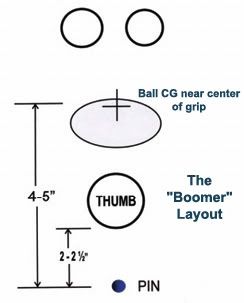A Trio of ‘Way-Out’ Layouts
Bizarre drillings from bowling’s World SeriesIN WINNING TITLES at the World Series of Bowling, Rhino Page and Mike DeVaney used (at least part of the time) equipment with what might be called bizarre layouts. We’re talking about pins placed about two inches below their respective thumb holes.
The idea was hatched a couple of years ago by Storm executive Hank Boomershine as an alternative to more conventional drillings that can produce skid/flip and a violent reaction off the pattern, at least with the more heavy-handed players.

When the Storm staffers encountered the high-friction surface at Thunderbowl Lanes, some were in trouble. So tour rep Chris Schlemer dusted off Boomershine’s idea, and it worked (we refer to it here as the “Boomer” layout).
Schlemer explains, “If you get the pin out far enough, in effect you are inverting the core.” That, of course, is in relation to the ball track, and helps it get into an earlier roll.
And, of course, the relatively big and deep thumb hole is taking out some of the core mass near the pin (what Schlemer called “the meat of the core”). Thus, he says, “You’re balancing out the RG and differential, making it more symmetrical. It makes it more smooth and controlled.”
With the pin so far below the thumb, there’s a danger that the ball will have far too much thumb weight, so Schlemer advises starting with a 4-5” pin and low top. The CG should be near the grip center, but can go left or right (with appropriate balance hole).
Can it work for the league bowler? If the bowler is having trouble with the ball “going sideways” off the spot, yes. Also, Schlemer says it can benefit the straight player who has to start in the dry.
While the Boomer layout is designed to decrease differential, RICO does essentially the opposite. RICO, named after inventor Ric Hamlin, puts the pin smack in the center of the grip, with the CG exactly 45° away (the 4:30 position for RHs), and a balance hole on a line through the CG exactly 6¾” from the pin. Hamlin says it’s important to drill the balance hole into the core, to “reshape” it, making it more dynamic.
Hamlin developed the layout six years ago. Says he, “it creates the strongest amount of asymmetry (in a symmetrical ball), the strongest amount of imbalance.” Yet it tends to decrease flip while maintaining continuation.
The layout has been successful on lanes with dry backends. “A normal layout tends to accentuate the oil, and when the ball sees friction, it wants to go sideways and becomes uncontrollable,” Hamlin says, but RICO smoothes out the move off the oil.
It may not be the best ball for a house pattern, but Hamlin says it should be in the arsenal of players who hit PBA or Sport conditions.
His experience has been that “if guys didn’t have a good reaction with their regular equipment, it was pretty much guaranteed that this would give them a different reaction.”
Yet another “way-out layout” is the full roller — but in a ball that tracks below the thumb. Schlemer has drilled a couple for Liz Johnson when she needed a “hook-stop” reaction. It can work on house shots, but the bowler should be prepared for the irritating thumping as the ball rolls over the thumb hole (due to inverted flare).
These layouts probably won’t do much for most league bowlers. But if you have customers who can’t control flip, or who just are not satisfied with the standard drillings, a “way-out layout” may be worth a try.
Dennis Bergendorf
*Posted with permission from Luby Publishing Inc.

